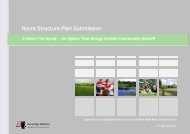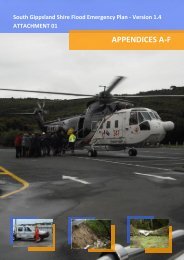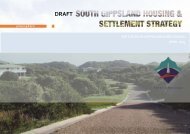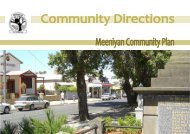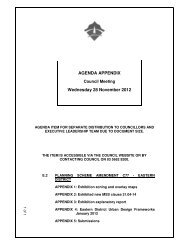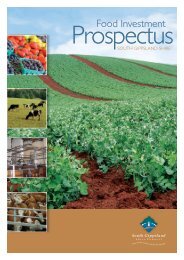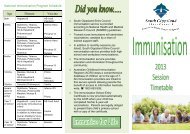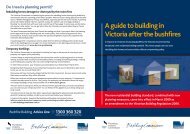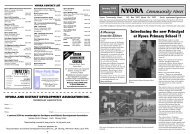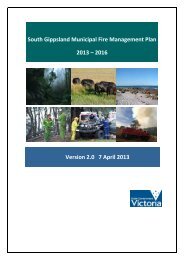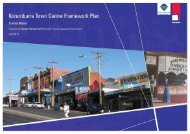Planning Permits & Potable Water Supply Catchments - South ...
Planning Permits & Potable Water Supply Catchments - South ...
Planning Permits & Potable Water Supply Catchments - South ...
You also want an ePaper? Increase the reach of your titles
YUMPU automatically turns print PDFs into web optimized ePapers that Google loves.
L<br />
ooking to use or develop land within an<br />
open potable* water supply catchment<br />
area<br />
<strong>Planning</strong> <strong>Permits</strong> & <strong>Potable</strong> <strong>Water</strong><br />
<strong>Supply</strong> <strong>Catchments</strong><br />
If your property is within one of these areas,<br />
then new guidelines may affect you!<br />
(*drinkable)<br />
BACKGROUND<br />
A potable water supply catchment provides water<br />
resources to a reservoir (or water storage) used<br />
for domestic water supply purposes. An ‘open’,<br />
potable water supply catchment is a catchment<br />
where all or part of it is in private ownership and<br />
access to the catchment is unrestricted.<br />
Open, potable water supply catchments are declared to<br />
be special water supply catchments under the<br />
Catchment and Land Protection Act 1994. There are<br />
currently nine such catchments (in full or in part) in<br />
<strong>South</strong> Gippsland Shire. Most of these are covered by a<br />
specific overlay within the <strong>Planning</strong> Scheme, known as<br />
the ESO2 (Environmental Significance Overlay –<br />
Schedule 2).<br />
However, the Tarwin River (Meeniyan) <strong>Water</strong> <strong>Supply</strong><br />
Catchment, which has an area of approximately 1053<br />
km 2 , is the largest in the Shire and is not currently<br />
covered by such an Overlay.<br />
The State Government has developed guidelines to<br />
protect the quality of potable water supplies, using a<br />
risk based approach. One of the mechanisms used to<br />
protect the quality of water in these catchments is to<br />
control the density of dwellings and their on-site waste<br />
water (effluent) systems.<br />
Council and the relevant water authority must consider<br />
these new guidelines, <strong>Planning</strong> permit applications in<br />
open, potable water supply catchment areas (DSE,<br />
November 2012) when assessing <strong>Planning</strong> Permit<br />
applications for:<br />
using land for a dwelling,<br />
<br />
<br />
subdividing land, or<br />
situations where a planning permit to develop<br />
land is required due to the Environmental<br />
Significance Overlay.<br />
DWELLING DENSITY<br />
Guideline 1 refers to the density of dwellings and it<br />
requires dwelling density to be no greater than one<br />
dwelling per 40 hectares (1:40 ha) within the catchment.<br />
The Victorian Civil and Administrative Tribunal (VCAT)<br />
and the Victorian Supreme Court have both stated that<br />
when considering applications in open, potable water<br />
supply Catchment areas, risk to human health is highly<br />
relevant, and, because of its serious nature, must be<br />
given priority over other planning objectives.<br />
There are currently four categories of exemptions from<br />
Guideline 1, although these are not currently available<br />
in this Shire for the Tarwin River (Meeniyan)<br />
Catchment.<br />
The Victorian <strong>Water</strong> Association (Vic<strong>Water</strong>) has also<br />
released a guideline (February 2013) which assists in<br />
calculating dwelling density using a 1km radius method.<br />
This method has been generally acknowledged by<br />
VCAT and adopted by some water authorities.<br />
PTO for frequently asked questions<br />
Last updated 22/05/2013
FREQUENTLY ASKED QUESTIONS<br />
What does this mean if my property is in the<br />
catchment<br />
If you already use, or have developed your property the<br />
guidelines should not affect you or your property in any<br />
significant way. However, if you require a planning<br />
permit for any of the matters listed previously, then this<br />
may affect you.<br />
Currently, the most common applications that are<br />
affected by the guidelines are for the use of dwellings in<br />
the Farming Zone on lots of less than 40 hectares;<br />
however, you may also be affected in other<br />
circumstances.<br />
If you are unsure if your proposal will be affected, you<br />
can call Council’s Statutory <strong>Planning</strong> Department on<br />
(03) 5662 9200 to find out.<br />
If I require a permit, what does this mean<br />
If you require a planning permit then the guidelines will<br />
need to be addressed in your application. The<br />
application will be referred to the relevant water<br />
authority (<strong>South</strong> Gippsland <strong>Water</strong> Corporation and/or<br />
Gippsland <strong>Water</strong> in this Shire) under Section 55 of the<br />
<strong>Planning</strong> and Environment Act 1987 and it will be<br />
assessed according to the guideline.<br />
If my application does not comply with the<br />
guideline what does this mean<br />
If your application does not comply with the guideline<br />
(particularly Guideline 1) then Council or the relevant<br />
water authority may refuse to issue a permit. If the<br />
water authority refuses consent to issue the permit, the<br />
Council has no power to issue it.<br />
What are my options<br />
If your application does not comply with the guideline<br />
and Council or the water authority is likely to refuse the<br />
permit on that basis, then you have two options:<br />
Council can issue a notice of refusal for the<br />
application, stating its reasons and those of any<br />
other authority. You have the right to appeal this<br />
decision to VCAT; or<br />
You may wish to withdraw or withhold your<br />
application until Council and the relevant water<br />
authority are able to explore viable options.<br />
What are Council and the relevant water authority<br />
doing<br />
Council and the relevant water authority have<br />
commenced exploring viable options under the four<br />
categories of exemptions to Guideline 1. Each of the<br />
options is potentially costly and would require significant<br />
resources to implement.<br />
Council will release further updates on the matter when<br />
progress is made.<br />
Where can I get a copy of the DSE and Vic<strong>Water</strong><br />
guidelines<br />
Council’s website contains a link to both guidelines on<br />
its front page www.southgippsland.vic.gov.au and under<br />
the Statutory <strong>Planning</strong> section.<br />
If you have any queries in the meantime please contact<br />
the Statutory <strong>Planning</strong> Department on (03) 5662 9200.<br />
Figure 1: Map of Catchment Area<br />
Last updated 22/05/2013



